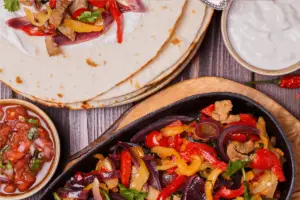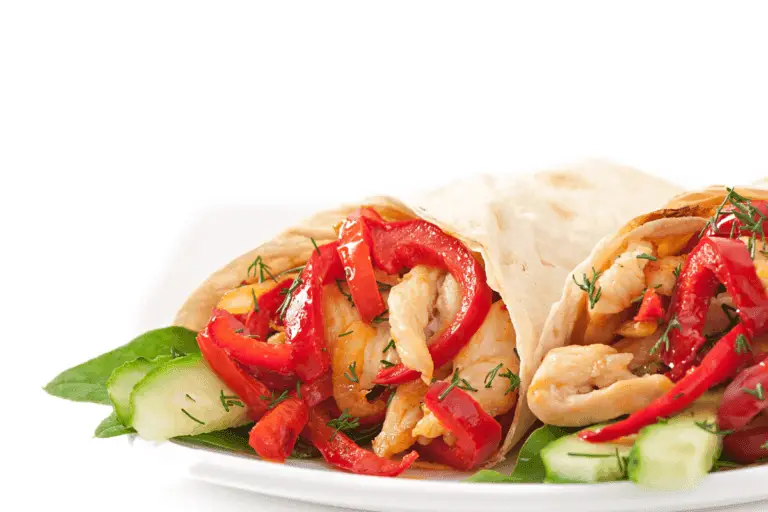Maria’s Fajita Chicken is a beloved dish celebrated for its robust flavors and ease of preparation. The recipe is known for its perfectly balanced seasoning, which ensures that every bite is packed with a harmonious blend of spices. A crucial component of this balance is salt, a seemingly simple ingredient that has the power to transform any dish. Understanding how much salt in Maria’s fajita chicken is required can make all the difference in achieving that signature taste.
Salt enhances the natural flavors of ingredients, improves texture, and harmonizes other spices in the dish. In Maria’s Fajita Chicken, balancing the salt ensures the rich flavors of the chicken, peppers, and spices shine through. Understanding the right amount of salt transforms the dish from ordinary to extraordinary. If you love mastering flavorful dishes, you might enjoy exploring the ultimate guide to lasagna perfection, another recipe that benefits from meticulous seasoning.
Ingredients of Maria’s Fajita Chicken
The ingredients for Maria’s Fajita Chicken are simple yet flavorful, making it a go-to recipe for many home cooks. However, the question of how much salt in Maria’s fajita chicken remains critical for achieving the perfect taste. Below is a list of typical ingredients used:

- Bell peppers (assorted colors)
- Onions (thinly sliced)
- Olive oil
- Lime juice
- Garlic (minced)
- Chili powder
- Cumin
- Paprika
- Salt (precisely measured for balance)
- Black pepper
- Fresh cilantro
Precision in measuring salt is crucial, as it ensures every bite is perfectly seasoned. For those who love exploring rich dessert recipes after a savory meal, the red velvet cake cookies guide is a must-read.
The Role of Salt in Cooking Fajitas
Understanding the role of salt is essential when answering the question of how much salt in Maria’s fajita chicken. Salt performs multiple functions in cooking:
- Enhances Flavor: It amplifies the natural taste of the chicken and vegetables.
- Improves Texture: Proper salting helps retain the chicken’s juiciness by promoting moisture absorption.
- Balances Seasoning: It creates harmony among other spices like cumin and paprika.
Without sufficient salt, the fajitas may taste bland, even if other spices are included. Conversely, too much salt can overwhelm the dish, masking the nuanced flavors of the marinade. The key is to strike the perfect balance, which requires careful measurement and testing.
Standard Salt Measurements in Recipes
Recipes often suggest a general guideline for salt measurements, but variations are common depending on the dish and personal preferences. For fajitas, the following standard applies:
- Chicken: 1 teaspoon of salt per pound of chicken.
- Vegetables: ½ teaspoon of salt per cup of sliced vegetables.
- Marinade: 1 teaspoon of salt per 2 tablespoons of liquid.
When considering how much salt in Maria’s fajita chicken to use, it’s crucial to measure accurately while leaving room for adjustments. Adding salt incrementally during the cooking process allows better control over the final taste.
Maria’s Original Recipe Breakdown
Maria’s recipe for fajita chicken stands out due to its meticulous attention to seasoning. To determine how much salt in Maria’s fajita chicken is required, we can analyze the original recipe:
- Marinade: Includes lime juice, olive oil, and a blend of spices with 1 teaspoon of salt.
- Chicken: Requires an additional 1 teaspoon of salt for every pound.
- Vegetables: Calls for a light sprinkle, roughly ½ teaspoon of salt per serving.
By combining these elements, Maria ensures that the overall seasoning is consistent throughout the dish. Adhering to these proportions is key to replicating the authentic taste of her fajitas.
Modifications in Salt Levels
Adjusting salt levels is sometimes necessary to meet dietary restrictions or personal preferences. If you’re wondering how much salt in Maria’s fajita chicken can be modified without compromising flavor, consider the following:
Reducing Salt
- Use low-sodium substitutes or herbs like parsley and oregano for added flavor.
- Rely on citrus juice or vinegar to enhance brightness without salt.
- Decrease the amount of salt in the marinade and season the finished dish lightly.
Increasing Salt
- Add a pinch more salt if the dish tastes under-seasoned after cooking.
- Sprinkle flaky salt as a finishing touch for texture and flavor bursts.
Adjusting salt requires tasting frequently, ensuring the balance remains intact while catering to specific needs.
Impact of Too Much or Too Little Salt
The amount of salt in Maria’s fajita chicken greatly affects the dish’s outcome. Understanding the implications of over- or under-salting can help refine your approach.
- Too Much Salt: Over-salted fajitas can feel overpowering and diminish the enjoyment of other flavors. To fix this, add unsalted vegetables or serve with a bland side dish.
- Too Little Salt: Under-salted fajitas may lack depth and fail to excite the palate. Gradually add more salt during cooking to enhance the flavor.
By focusing on how much salt in Maria’s fajita chicken is optimal, you can ensure the dish delivers the perfect culinary experience.
By carefully managing salt levels, Maria’s Fajita Chicken remains an iconic recipe loved by many. Balancing flavor, texture, and seasoning ensures every bite lives up to its reputation as a mouthwatering delight.
Tips to Measure Salt Perfectly
Measuring salt accurately is essential when determining how much salt in Maria’s fajita chicken will yield the best results. Proper measurements prevent the dish from being overly salty or bland. To achieve precision:
- Use Measuring Spoons: Always rely on standard measuring tools rather than guessing.
- Account for Ingredients: Remember that certain ingredients, such as marinades or store-bought seasonings, may already contain salt.
- Layer Seasoning: Add salt gradually during cooking to achieve the desired taste.
- Test as You Go: Tasting the dish at each step ensures the salt level remains balanced.
An ideal starting point for fajitas is 1 teaspoon of salt per pound of chicken. For vegetables, ½ teaspoon of salt per cup works well. Keeping these proportions in mind while cooking ensures consistent and flavorful results every time.
How to Adjust Salt in the Cooking Process
Adjusting how much salt in Maria’s fajita chicken during the cooking process is key to correcting imbalances. Whether the dish is over- or under-salted, simple strategies can restore the flavor.
Adjusting for Too Little Salt:
- Gradually sprinkle additional salt, mixing thoroughly after each addition.
- Add soy sauce or tamari to boost saltiness without altering the dish’s overall profile.
- Incorporate salty condiments like Worcestershire sauce if needed.
Adjusting for Too Much Salt:
- Introduce unsalted ingredients such as additional vegetables or chicken to dilute the salt.
- Add acidity, like lime juice or vinegar, to counteract the salty flavor.
- Serve the fajitas with bland accompaniments, like plain rice or tortillas, to balance the meal.
These tips make it easy to fine-tune the salt content and ensure Maria’s Fajita Chicken maintains its signature taste.
Health Implications of Salt in Maria’s Fajita Chicken
Understanding how much salt in Maria’s fajita chicken is appropriate extends beyond flavor—it impacts health. Sodium, a key component of salt, plays an essential role in bodily functions, but excessive intake can lead to health concerns.
Benefits of Proper Salt Levels:
- Regulates fluid balance in the body.
- Supports nerve and muscle function.
Risks of Excessive Salt:
- Increases blood pressure, leading to hypertension.
- May contribute to cardiovascular issues over time.
Maria’s recipe strikes a balance by using just enough salt to enhance flavor without overwhelming the dish. For individuals with dietary restrictions, low-sodium alternatives or reduced salt portions can provide a healthier option without sacrificing taste.
Salt Substitutes and Alternatives
For those aiming to reduce sodium intake, understanding how much salt in Maria’s fajita chicken can be modified is crucial. Substitutes and alternatives can provide flavor without the excess sodium.
- Herbs and Spices: Garlic powder, onion powder, smoked paprika, and cumin add depth without relying on salt.
- Citrus Juices: Lime or lemon juice brightens the dish and enhances other flavors.
- Low-Sodium Soy Sauce: A flavorful alternative that cuts down on sodium.
- Salt-Free Seasoning Blends: Pre-mixed options, like Mrs. Dash, are convenient for fajitas.
Experimenting with these alternatives allows you to customize Maria’s recipe while maintaining its signature taste and reducing salt content as needed.
Regional Variations in Fajita Recipes
The amount of salt in Maria’s fajita chicken can also vary depending on regional preferences. Across different cuisines, fajita recipes reflect unique approaches to seasoning.
- Tex-Mex Style: Typically uses a robust spice blend with moderate salt to balance smoky flavors.
- Mexican Variations: Focuses on fresh ingredients like lime juice and cilantro, often requiring less salt.
- Fusion Styles: Incorporates global influences, such as Asian marinades, which may have higher sodium levels from soy sauce or miso.
Regional variations highlight the versatility of fajitas, offering a variety of ways to adjust salt while celebrating local tastes. Maria’s version stays true to its roots with a balanced approach that can be adapted to any regional preference.
Customer Reviews of Maria’s Recipe
Customer feedback on Maria’s recipe often emphasizes the importance of how much salt in Maria’s fajita chicken contributes to the dish’s success. Reviews reveal common trends:
- Positive Comments: Many praise the perfect balance of seasoning, noting that the salt enhances the natural flavors of the chicken and vegetables.
- Constructive Feedback: Some suggest reducing salt for those with dietary restrictions, highlighting the recipe’s adaptability.
- Common Tips: Users recommend tasting throughout the cooking process to achieve the right salt balance.
Maria’s fajita chicken consistently earns high marks for its flavor, showcasing the vital role salt plays in creating a crowd-pleasing meal.
FAQs
Are Chicken Fajitas High in Sodium?
Chicken fajitas can vary in sodium content depending on how they are prepared. If you use pre-packaged fajita seasoning or marinade, the sodium levels are often higher due to added salt and preservatives. On average, a restaurant-style chicken fajita dish can contain anywhere from 800 to 1500 milligrams of sodium per serving, primarily from seasoning, marinades, and accompaniments like tortillas.
To lower sodium, consider making homemade fajita seasoning with reduced salt, or substitute with fresh herbs and spices. Measuring how much salt in Maria’s fajita chicken is added during preparation can also help control the sodium level.
How Much Sodium Is in Fajita Seasoning?
The sodium content in fajita seasoning largely depends on whether it’s store-bought or homemade. Pre-packaged fajita seasoning can contain 250 to 400 milligrams of sodium per teaspoon. If a recipe requires 2–3 teaspoons, the sodium quickly adds up.
Making fajita seasoning at home allows you to control how much salt in Maria’s fajita chicken you include. For a low-sodium version, reduce or omit salt and enhance flavor with spices like cumin, chili powder, and garlic powder.
How Much Salt in Chicken Marinade?
When preparing chicken marinades, salt is a crucial ingredient for flavor and tenderizing. A typical marinade recipe calls for 1 to 2 teaspoons of salt per cup of marinade liquid. This amount ensures the chicken absorbs enough seasoning without becoming overly salty.
If you’re modifying how much salt in Maria’s fajita chicken marinade to reduce sodium, substitute part of the salt with acidic ingredients like lime juice or vinegar, which also help tenderize the meat.
How Much Salt in Chicken Quesadilla?
The salt content in a chicken quesadilla depends on the recipe, especially the chicken seasoning, tortillas, and cheese used. On average, a chicken quesadilla contains 600 to 1200 milligrams of sodium per serving, with most of it coming from cheese and pre-seasoned chicken.
To control the sodium levels, season the chicken with a light sprinkle of salt (approximately ½ teaspoon per pound), use low-sodium tortillas, and choose reduced-sodium cheese. By managing how much salt in Maria’s fajita chicken or quesadilla filling, you can make a healthier and more balanced version of this popular dish.
Conclusion
Understanding how much salt in Maria’s fajita chicken is essential for recreating its authentic flavor and maintaining a healthy balance. By carefully measuring, adjusting, and even experimenting with alternatives, you can ensure the dish remains flavorful and suitable for all dietary needs.
Maria’s recipe is a testament to the importance of precise seasoning, proving that even simple adjustments to salt can elevate a dish to perfection. Whether following the original recipe or customizing it to suit your preferences, the role of salt in Maria’s fajita chicken cannot be understated.
Print
Maria’s Fajita Chicken
- Prep Time: 15 minutes
- Cook Time: 20 minutes
- Total Time: 35 minutes
- Yield: 4
- Category: Main Dish
- Method: Sautéing
- Cuisine: Tex-Mex
- Diet: Gluten Free
Description
Discover how much salt in Maria’s fajita chicken creates its iconic flavor. Explore precise measurements, seasoning tips, and healthy adjustments to perfect this classic recipe
Ingredients
Chicken: 1 pound of boneless, skinless chicken breast or thighs
Bell Peppers: 2 medium-sized (assorted colors, sliced)
Onion: 1 medium-sized, thinly sliced
Olive Oil: 2 tablespoons
Lime Juice: 2 tablespoons (freshly squeezed)
Garlic: 3 cloves, minced
Chili Powder: 1 teaspoon
Cumin: 1 teaspoon
Paprika: 1 teaspoon
Salt: 1 teaspoon (adjusted as needed)
Black Pepper: ½ teaspoon
Fresh Cilantro: 2 tablespoons, chopped (optional, for garnish)
This blend of ingredients ensures a rich and flavorful fajita chicken, perfectly balanced with the right amount of seasoning.
Instructions
Prepare the Marinade:
In a bowl, whisk together the olive oil, lime juice, minced garlic, chili powder, cumin, paprika, salt, and black pepper. This will serve as the marinade for the chicken.
Marinate the Chicken:
Slice the chicken into thin strips. Place it in a resealable bag or shallow dish.
Pour the marinade over the chicken, ensuring each piece is coated evenly.
Cover and refrigerate for at least 30 minutes or up to 2 hours for maximum flavor.
Cook the Chicken:
Heat a large skillet or grill pan over medium-high heat. Once hot, add the marinated chicken strips.
Cook for 6-8 minutes, stirring occasionally, until the chicken is browned and cooked through (internal temperature should reach 165°F).
Sauté the Vegetables:
In the same skillet, add a bit of olive oil if needed. Toss in the sliced bell peppers and onions.
Cook for 5-7 minutes until the vegetables are tender-crisp and slightly charred.
Combine and Serve:
Return the cooked chicken to the skillet with the vegetables. Toss everything together and cook for an additional 2 minutes to meld the flavors.
Remove from heat and sprinkle with fresh cilantro if desired.
Notes
Adjust Salt to Taste:
Start with 1 teaspoon of salt in the marinade and adjust as needed during cooking. Taste frequently to ensure a balanced flavor.
Marinating Time:
For deeper flavor, marinate the chicken overnight in the refrigerator. If short on time, a 30-minute marination will still yield great results.
Nutrition
- Serving Size: Approximately 1/4 of the total recipe
- Calories: 250 kcal
- Sugar: 3 g (from vegetables and marinade)
- Sodium: 600 mg (depending on salt adjustments)
- Fat: 12 g
- Saturated Fat: 2 g
- Unsaturated Fat: 9 g
- Trans Fat: 0 g
- Carbohydrates: 8 g (from vegetables and marinade)
- Fiber: 2 g
- Protein: 30 g (from chicken)
- Cholesterol: 75 mg


